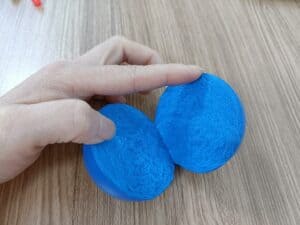Have you ever squeezed a stress ball during a tense moment and wondered what makes it feel so delightfully squishy and resilient?
These handy desk companions are more than just tools for stress relief; they are small marvels of material science and engineering. Each squeeze not only provides a sense of calm but also engages intricate material properties that offer a satisfying tactile experience.
In this article, we will delve deep into the world of stress balls, exploring the various materials used in their construction and the fascinating chemistry behind their stress-relieving magic.
The Science Behind Stress Balls
Stress balls are typically crafted from polyurethane, a flexible and durable polymer that excels at absorbing physical pressure. Polyurethane is produced through a fascinating chemical process where monomers, such as isocyanates and polyols, react to create long polymer chains. This chemical reaction results in a material that can be squeezed repeatedly without losing its shape, making it ideal for stress relief.
While the primary function of all stress balls is to alleviate tension, the specific materials used can vary widely. Each type of material offers a distinct tactile experience, tailored to suit diverse preferences and needs.
What Materials Are Used in Stress Balls?
PU Foam Stress Balls
PU foam stress balls are made from non-toxic polyurethane foam, characterized by their lightness and springy nature. The foam contains tiny air bubbles that provide satisfying resistance when squeezed, making them both fun and therapeutic to use.
Squishy Gel Balls
These stress balls are filled with a thick, often colorful gel that molds to the shape of your hand. The gel is typically composed of a silicone compound, renowned for its durability and non-toxic properties. The viscosity of the gel can be adjusted to create varying resistance levels, offering a customizable stress-relief experience.
Water Bead Filled Stress Balls
These contain a gel or thick liquid encased in a flexible outer shell. The liquid usually consists of a water-based solution mixed with glycerin, creating a soothing, slow-motion squish effect when pressed. People love these for their mesmerizing texture and visually appealing properties.
Are the Materials Inside Stress Balls Toxic?
Safety is paramount when it comes to stress balls. The materials used, such as polyurethane foam and silicone gels, are generally non-toxic and safe for users of all ages. Manufacturers adhere to international safety standards, ensuring that these stress-relief tools are not only effective but also safe for frequent use.
Choosing a reliable supplier, like us, guarantees that the stress balls meet stringent safety requirements. It’s important to trust suppliers who prioritize quality and safety in their production processes.
What Are the Benefits of Stress Balls?
Stress balls offer more than just relaxation; they bring numerous physical benefits as well. PU foam stress balls, in particular, are highly effective in promoting both mental and physical well-being.
One of the less obvious advantages of using stress balls is their ability to enhance focus and concentration. The repetitive squeezing action helps to relieve muscle tension, particularly in the arms and shoulders. Additionally, using stress balls improves blood circulation to the hands and fingers, strengthens grip, and aids in muscle recovery for those with injuries.
Regular use of stress balls can trigger the release of endorphins, the body’s natural feel-good chemicals, which contribute to an overall sense of well-being. Stress balls are also beneficial for hand rehabilitation, commonly used by individuals recovering from injuries or dealing with conditions like arthritis or carpal tunnel syndrome.
Conclusion
Understanding the materials inside your stress ball can significantly influence your purchasing decision. Whether you’re using them to decompress at work, as a therapeutic tool, or to build hand strength, being aware of what’s inside can help you select the best and safest option.
Different types of stress balls offer unique benefits. They not only assist in relaxation but also contribute to healthier and stronger hands. By choosing the right type, you can maximize both the mental and physical advantages these simple yet powerful tools provide.




